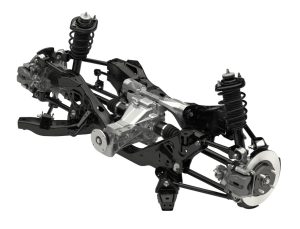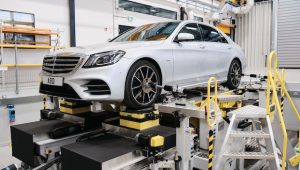When it comes to a car’s handling and stability, suspension kinematics — the study of how suspension components move in relation to each other — plays a central role. Every bump, corner, and acceleration transfers forces through the suspension system, which directly affects how your tires grip the road.
While terms like camber, toe, and caster might sound technical, understanding the basics of suspension movement can help you appreciate how vital this system is for safety, comfort, and performance.
What Is Suspension Kinematics?

In simple terms, suspension kinematics describes how the geometry of the suspension changes as the wheels move up and down relative to the chassis. These movements determine how the tires maintain contact with the road surface during acceleration, braking, and cornering.
Suspension kinematics focuses on:
-
Wheel travel (vertical movement)
-
Camber and toe changes
-
Roll center movement
-
Pitch and dive behavior
-
Load transfer between wheels
Every vehicle suspension design — whether MacPherson strut, double wishbone, or multi-link — uses geometry to balance comfort and control.
Key Terms in Suspension Kinematics
| Term | Description | Effect on Handling |
|---|---|---|
| Camber | Angle of the wheel relative to vertical | Affects tire contact patch in corners |
| Caster | Forward or backward tilt of the steering axis | Improves straight-line stability |
| Toe | Direction wheels point relative to vehicle centerline | Impacts tire wear and turn response |
| Roll Center | The pivot point around which the car rolls in corners | Determines body roll and weight transfer |
| Bump Steer | Unwanted steering input caused by suspension travel | Reduces predictability during bumps |
Understanding how these parameters change dynamically (as the car moves) is key to tuning suspension behavior.
The Role of Geometry in Tire Grip
Tire grip depends heavily on how evenly the tire contacts the road surface. Suspension kinematics ensures this contact remains as stable as possible under different driving conditions.
Factors that influence grip:
-
Camber Gain: When a car corners, the outside wheel tilts inward (negative camber) to keep the tire flat on the road.
-
Roll Steer: Rear suspension movement can slightly steer the wheels during body roll, stabilizing the car.
-
Anti-Dive and Anti-Squat Geometry: These limit excessive pitch during braking or acceleration, improving traction.
If geometry isn’t correctly balanced, tire contact patches shrink — leading to reduced traction, uneven tire wear, and unpredictable handling.
Common Suspension Layouts and Their Kinematic Traits
| Suspension Type | Advantages | Drawbacks | Typical Use |
|---|---|---|---|
| MacPherson Strut | Simple, compact, inexpensive | Limited camber control | Economy and mid-size cars |
| Double Wishbone | Excellent camber control, precise handling | More complex and costly | Sports and performance cars |
| Multi-Link | Highly adjustable, balances comfort and control | Heavier, expensive to repair | Premium sedans, SUVs |
| Trailing Arm / Torsion Beam | Durable and space-efficient | Less dynamic control | Budget and compact vehicles |
Different designs affect how forces travel through the chassis — influencing ride comfort, steering feedback, and traction under load.
How Suspension Movement Affects Handling Dynamics
When your suspension moves, several geometry changes happen simultaneously:
1. Camber Change
During cornering, the suspension compresses on the outside and extends on the inside. A properly tuned suspension gains negative camber, helping the outer tire maintain full contact.
2. Roll Center Migration
As the suspension moves, the roll center height changes. A stable roll center keeps the vehicle predictable in turns; too much movement leads to excessive body roll or sudden transitions.
3. Toe Change (Bump Steer)
Improperly designed link geometry can cause wheels to steer slightly as they move vertically. This “bump steer” reduces driver confidence and can make the car feel twitchy on uneven surfaces.
4. Load Transfer
Weight shifts between tires during acceleration and braking. Good suspension geometry minimizes uneven load transfer, ensuring each tire maintains consistent grip.
How Improper Kinematics Affects Performance
If your suspension geometry drifts out of specification due to worn parts or poor setup, you might experience:
-
Uneven tire wear (especially inner or outer edges)
-
Steering pull or vibration
-
Unstable handling on rough roads
-
Reduced braking efficiency
-
Increased fuel consumption from drag
Even small misalignments can significantly affect safety and performance. That’s why it’s essential to inspect suspension components regularly and replace worn bushings, ball joints, or control arms with quality parts.
You can always Buy Suspension online to find OEM and aftermarket options suitable for your vehicle.
Practical Tips to Maintain Proper Suspension Kinematics
-
Regular Alignment Checks: Have your alignment inspected every 20,000–30,000 km or after hitting potholes.
-
Replace Worn Bushings and Joints: Excess play in these parts causes geometry drift.
-
Maintain Equal Tire Pressure: Uneven pressure alters handling balance.
-
Check Ride Height: Sagging springs can distort suspension angles.
-
Use OEM or High-Quality Replacements: Low-quality parts often alter suspension geometry.
By following these practices, you preserve the designed kinematic performance — ensuring maximum grip and predictable behavior.
The Future of Suspension Kinematics

Automotive technology is evolving fast, and adaptive and active suspensions are redefining how kinematics work in real time.
| Technology | Description | Benefit |
|---|---|---|
| Active Suspension | Uses sensors and actuators to adjust damping and geometry | Real-time response to road and driver inputs |
| Semi-Active Damping | Adjusts shock absorber stiffness dynamically | Improved comfort and handling balance |
| Predictive Systems | Uses cameras and radar to pre-adjust suspension | Anticipates bumps for smoother ride |
| Electronic Roll Control | Controls roll center through active stabilizers | Reduces body roll and enhances cornering grip |
Future systems may continuously optimize toe, camber, and roll center as the car moves — something fixed mechanical systems can’t do. This means better grip, comfort, and energy efficiency without compromise.
Table: Kinematic Goals vs. Results
| Kinematic Goal | Desired Outcome | Result of Poor Setup |
|---|---|---|
| Maintain tire contact patch | Maximum traction | Uneven grip, tire wear |
| Control roll center migration | Predictable cornering | Unstable handling |
| Minimize bump steer | Steering precision | Vehicle twitchiness |
| Balance camber gain | Uniform tire load | Loss of grip during turns |
| Limit pitch and dive | Stable braking/acceleration | Nose dive or squat |
Conclusion
Suspension kinematics is the science that keeps your car balanced, predictable, and safe. It determines how your tires interact with the road, how forces transfer through the chassis, and ultimately, how confident you feel behind the wheel.
Whether you drive a sports coupe or a family sedan, understanding these principles helps you recognize the importance of proper maintenance and component quality.
When it’s time to replace parts or fine-tune your system, make sure to Buy Suspension online to ensure correct geometry, durability, and consistent handling performance.